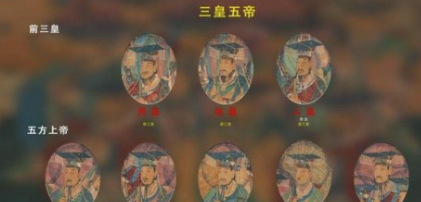The Three Sovereigns and Five Emperors are legendary monarchs in ancient China, including the "Three Sovereigns" and the "Five Emperors".

The Three Sovereigns and Five Emperors are very famous legendary figures in ancient Chinese history, and they are considered as cultural heroes and ancestors of the Chinese nation. In traditional narratives, the "Three Sovereigns" usually refer to Fuxi, Shennong, and Huangdi, while the "Five Emperors" refer to Shaohao, Zhuanxu, Diku, Yao, and Shun.
1. The Three Sovereigns:
- Fuxi: Considered as the cultural ancestor of the Chinese nation, he is said to have created the Eight Trigrams, laying the foundation for the wisdom of Chinese civilization.
- Shennong: Also known as Yan Di, he is legendarily known for personally tasting various herbs to discern their toxicity and efficacy, having a significant impact on the development of ancient Chinese agriculture and medicine.
- Huangdi: Also known as Xuanyuan, he is respected as the common ancestor of the Chinese nation. Legend has it that he unified various tribes in China and created cultural achievements such as writing, music, and calendar.
2. The Five Emperors:
- Shaohao: Also known as Jintian, he was the eldest son of Huangdi. He inherited his father's virtuous governance, leading to social stability and prosperity.
- Zhuanxu: Also known as Gaoyang, he governed the country with benevolence and emphasized people's livelihood and education.
- Diku: Also known as Gaoxin, he was renowned for his wisdom and excelled in governing the country, enabling the people to live and work in peace and contentment.
- Yao: A wise and enlightened monarch, he was diligent in governing and loved his people. He implemented the system of abdication and selected capable individuals.
- Shun: The successor of Yao, he was also renowned for his virtues and continued to maintain social harmony and stability.
These legendary figures represent the ideal monarchs imagined by ancient Chinese people. Their deeds and inventions constitute the mythical origin of Chinese civilization. Although there is no direct archaeological evidence to prove their existence, the stories of the Three Sovereigns and Five Emperors have deeply influenced the cultural heritage and national development of China.
In addition, there are various opinions about the specific candidates of the Three Sovereigns and Five Emperors in history. For example, besides the mainstream views mentioned above, there are other combinations of the "Three Sovereigns" such as Suiren and Nüwa. This diversity reflects the rich imagination and constant reconstruction of mythology and legends in ancient China.
Disclaimer: The above content is sourced from the internet and the copyright belongs to the original author. If there is any infringement of your original copyright, please inform us and we will delete the relevant content as soon as possible.































